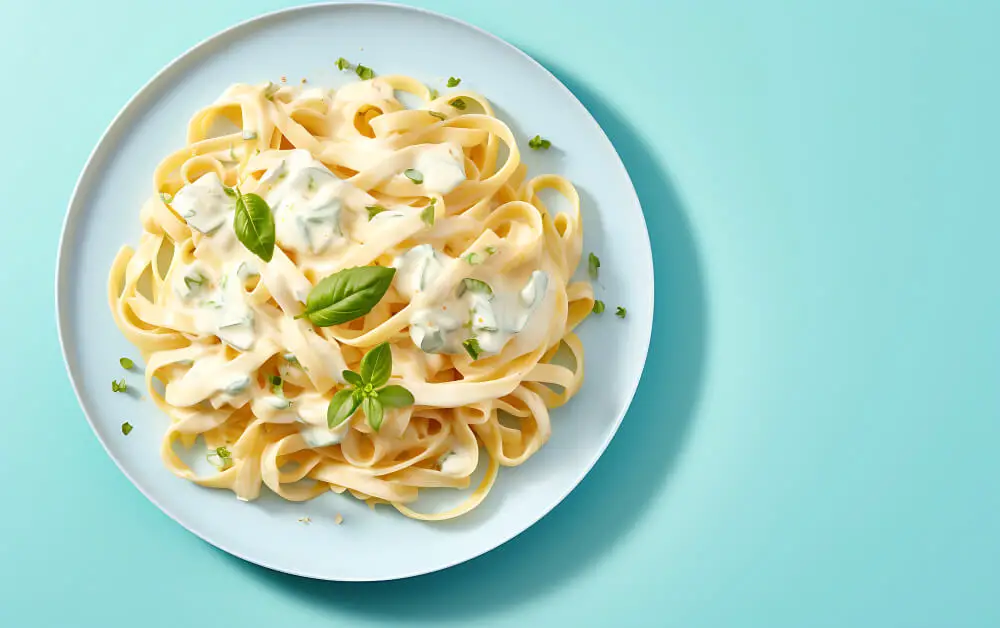Introduction to Pasta Fettuccine Carbonara
Introduction to the Dish
Pasta Fettuccine Carbonara, a dish synonymous with Italian culinary artistry, is a testament to the simplicity and elegance of Italy’s cuisine. Its origins, steeped in history, trace back to the Lazio region, with Rome often credited as its birthplace. The dish, which emerged in the mid-20th century, quickly gained popularity, becoming a beloved staple in Italian households and beyond.
The classic Carbonara is a harmonious blend of fettuccine pasta, eggs, cheese (typically Pecorino Romano or Parmesan), pancetta or bacon, and a generous seasoning of black pepper. Its creamy texture and rich flavor profile have captivated the palates of food enthusiasts worldwide.
Over time, Fettuccine Carbonara has seen numerous variations. Chefs and home cooks alike have experimented with ingredients, introducing elements like cream, different types of pasta, or even vegetarian substitutes for pancetta. Despite these variations, the essence of Carbonara remains rooted in its core ingredients and the traditional method of preparation, which emphasizes the importance of timing and technique to achieve the perfect creamy consistency without the use of cream.
Today, Pasta Fettuccine Carbonara stands not just as a dish but as a symbol of Italian culinary tradition, revered for its rich history, simplicity, and the delightful experience it offers to those who savor it. To further appreciate the diversity of Italian pasta, consider exploring the traditional Mafaldine Pasta, a culinary delight that showcases the regional uniqueness of Italy’s pasta cuisine.
Detailed Recipe and Cooking Techniques for Pasta Fettuccine Carbonara
Ingredients and Substitutes
The traditional Fettuccine Carbonara recipe is elegantly simple, requiring only a few key ingredients:
- Fettuccine Pasta: The flat, thick pasta noodles are ideal for holding the creamy sauce.
- Eggs: Typically, whole eggs or a combination of whole eggs and yolks are used to create the sauce.
- Pecorino Romano or Parmesan Cheese: These hard, salty cheeses add depth and richness.
- Pancetta or Guanciale: These Italian cured meats bring a unique, savory flavor.
- Garlic (optional): For an added flavor dimension.
- Salt and Black Pepper: For seasoning.
For those with dietary restrictions, several substitutes can be considered:
- Gluten-Free Pasta: For a gluten-free version.
- Turkey Bacon or Vegetarian Bacon: As alternatives to pancetta or guanciale.
- Dairy-Free Cheese: For lactose intolerance.
- Egg Substitutes: Such as silken tofu or cream for those who avoid eggs.
Step-by-Step Cooking Guide of Pasta Fettuccine Carbonara
- Preparation of Ingredients:
- Begin by slicing the pancetta into small pieces.
- Grate the cheese finely.
- If using, mince the garlic finely.
- In a bowl, beat the eggs and then mix in the grated cheese, adding a pinch of pepper.
- Cooking Process:
- Cook the fettuccine in a large pot of salted boiling water until al dente. Reserve some pasta water before draining.
- While the pasta cooks, sauté the pancetta (and garlic, if using) in a large skillet until the pancetta is crispy.
- Remove the skillet from heat. Add the drained pasta to the pancetta, tossing to combine.
- Quickly pour the egg and cheese mixture over the pasta, stirring rapidly. The heat from the pasta cooks the eggs, creating a creamy sauce.
- If the sauce is too thick, add a little of the reserved pasta water to reach the desired consistency.
- Serve immediately, garnished with additional grated cheese and a sprinkle of black pepper.
Tips and Tricks for Perfect Carbonara
- Cooking Pasta: Ensure the pasta is cooked to al dente. Overcooked pasta won’t hold the sauce well.
- Sauce Consistency: The key to a creamy Carbonara is in the eggs. Add them to the pasta off the heat to avoid scrambling. Stir quickly to create an emulsion.
- Pancetta: Cook the pancetta until it’s crispy but not burnt. This adds texture and a deep flavor to the dish.
- Cheese: Use freshly grated cheese for a smoother sauce.
- Timing: Carbonara waits for no one. Serve it as soon as it’s ready to enjoy its best texture and flavor.
Nutritional Information and Dietary Considerations for Pasta Fettuccine Carbonara
Health and Nutrition
Pasta Fettuccine Carbonara, while indulgent, provides a significant amount of energy and nutrients. A standard serving contains approximately 400-500 calories, primarily from carbohydrates and fats. The dish is rich in protein, thanks to the eggs and pancetta, offering about 15-20 grams per serving. It also provides essential nutrients like calcium from the cheese and B vitamins from the pasta and eggs. However, it’s relatively high in saturated fats and cholesterol, primarily due to the eggs and pancetta. The dish also contains a moderate amount of sodium, especially when salted pasta water and cured meats are used. As with many rich dishes, moderation is key to enjoying Carbonara as part of a balanced diet.
Dietary Variations
Adapting Fettuccine Carbonara for various dietary needs can be straightforward:
- Vegetarian: Replace pancetta with a vegetarian alternative like smoked tofu or a vegetarian bacon substitute. Some recipes use mushrooms for a similar umami flavor.
- Gluten-Free: Use gluten-free pasta. Many brands offer fettuccine-style noodles made from rice, corn, or other gluten-free grains.
- Dairy-Free: Opt for dairy-free cheese alternatives. Nutritional yeast can also add a cheesy flavor without actual cheese.
- Egg-Free: While less traditional, you can create a creamy sauce using cream or a plant-based cream alternative mixed with dairy-free cheese.
These variations ensure that the joy of a delicious Carbonara can be experienced by those with different dietary preferences or restrictions. For those who enjoy exploring the rich tapestry of Italian pasta dishes, the Garlic Parmesan Chicken Pasta offers a delightful fusion of flavors that’s sure to tantalize your taste buds.
Serving and Pairing Suggestions
Serving Suggestions for Pasta Fettuccine Carbonara
Presentation plays a key role in enhancing the appeal of Pasta Fettuccine Carbonara. Serve it hot, immediately after cooking, to savor its creamy texture. A twirl of pasta on a warm plate, garnished with a sprinkle of freshly grated cheese and a twist of black pepper, makes for an elegant presentation. Portion sizes are crucial; a standard serving of about one cup of pasta ensures a satisfying meal without overwhelming richness. For a touch of color and freshness, a light garnish of parsley can be added.
Pairing with Side Dishes
Side Dishes:
- A simple arugula salad with a lemon vinaigrette offers a refreshing contrast to the dish.
- Steamed or grilled asparagus, seasoned lightly, complements the pasta while adding a different texture.
- For a heartier meal, a side of garlic bread can be served, perfect for sopping up any leftover sauce.
These pairings and sides not only enhance the dining experience but also bring a balance to the meal, making Pasta Fettuccine Carbonara a truly satisfying dish.
Cultural and Culinary Context
Cultural Significance of Pasta Fettuccine Carbonara
In the realm of Italian cuisine, Pasta Fettuccine Carbonara is not just a dish; it’s a cultural icon. Originating in the Lazio region, particularly Rome, Carbonara has become emblematic of Italian culinary tradition. Its creation, post-World War II, is often attributed to the abundant supply of eggs and bacon from American troops, which Italian cooks ingeniously combined with pasta. Over the years, Carbonara has undergone regional adaptations, reflecting local tastes and ingredients. In some parts of Italy, you’ll find variations using different types of pasta, like spaghetti or rigatoni, or the addition of local ingredients like artichokes in spring. Despite these variations, the core elements of the dish – pasta, eggs, cheese, and pork – remain constant, symbolizing the simplicity and richness of Italian cooking.
Carbonara in Modern Cuisine
In contemporary cooking, Pasta Fettuccine Carbonara has transcended its traditional roots to become a global phenomenon. Chefs around the world have embraced and reinterpreted this classic, giving rise to fusion and innovative versions. From the addition of unconventional ingredients like seafood or truffles to vegetarian adaptations using zucchini or mushrooms, Carbonara’s versatility is continually being explored. In modern cuisine, it represents a bridge between traditional and innovative cooking, maintaining its essence while adapting to diverse palates and dietary preferences. This evolution reflects the dynamic nature of food culture, where respect for tradition meets the creativity of the present.
For a contemporary twist on classic pasta recipes that’s perfect for special occasions, the Marry Me Chicken Pasta is a must-try, blending traditional flavors with modern culinary creativity.
FAQs
- What are the essential ingredients for traditional Carbonara?
- Traditional Carbonara requires just a few key ingredients: pasta (typically spaghetti or fettuccine), eggs, Pecorino Romano or Parmesan cheese, pancetta or guanciale (Italian cured pork cheek), and black pepper. Some recipes also include garlic for added flavor.
- Can I use bacon instead of pancetta or guanciale in Carbonara?
- Yes, bacon is a common substitute, especially outside of Italy. While it alters the traditional flavor slightly, bacon still provides a delicious smokiness to the dish.
- Is cream used in authentic Carbonara?
- No, authentic Italian Carbonara doesn’t include cream. The creamy texture is achieved by emulsifying the cheese and eggs with the pasta’s heat and a bit of its cooking water.
Conclusion
In summary, Pasta Fettuccine Carbonara is a timeless classic that epitomizes the elegance and simplicity of Italian cuisine. With its rich history, minimal yet flavorful ingredients, and versatile nature, it’s a dish that appeals to a wide range of palates. Whether you stick to the traditional recipe or venture into creative variations, Carbonara offers a delightful culinary experience. I encourage you to embrace the art of making this dish, experimenting with different ingredients and techniques to find your perfect version. Remember, cooking is not just about following a recipe; it’s about creating something that brings joy to your table. So go ahead, give Pasta Fettuccine Carbonara a try, and savor the rich, creamy flavors of this beloved Italian dish.
Explore Carbonara Recipes at Taste of Home for more inspiration and enjoy the rich, creamy goodness of this Italian classic.


